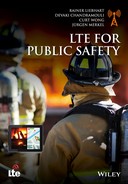Preface
Long-Term Evolution (LTE) has turned out to be a huge success story not only technology wise but also commercially. At the time of writing this book, more than 300 LTE networks are deployed around the world. The number of available LTE user devices is close to 1900 (figures are taken from Global Mobile Suppliers Association (GSA)). LTE technology allows addressing a wide market, potentially all Global System for Mobile Communications (GSM) and Universal Mobile Telecommunications System (UMTS) network operators, and also Code Division Multiple Access (CDMA) operators and even operators providing converged fixed and mobile networks. LTE provides in-built support for interworking with GSM/EDGE Radio Access Network (GERAN), Universal Terrestrial Radio Access Network (UTRAN), CDMA, Wireless Local Area Network (WLAN), and fixed broadband access. With 3rd Generation Partnership Program (3GPP), LTE is backed by a strong standardization organization. Corrections and enhancements to the LTE system are provided rapidly and are based on consensus among all major device and infrastructure vendors. In addition, LTE can operate in a large variety of frequency bands. In the future even unlicensed bands might be supported. All this together provides strong confidence in the LTE technology, in the standardization process, and in a reasonable total cost of ownership for all players (operators as well as vendors). Thus, LTE was a natural choice as the future mobile broadband radio technology for Public Safety networks not only in particular markets such as the United States or Europe but around the whole globe. LTE has the potential to replace existing narrowband Land Mobile Radio (LMR) systems that are currently in use, providing a variety of new and sophisticated services beyond voice to Public Safety personnel.
The main intention of this book is to explain how LTE can be used as technology enabler for Public Safety networks. For that purpose, we focus on describing the new Public Safety related features that were standardized in 3GPP Release 12 on top of LTE. As we do not require that all readers are fully familiar with LTE and its basic concepts, we give an overview of this technology and some of the most important services available in LTE, providing also a justification why LTE was adopted for future Public Safety networks. The reader can find a more detailed description of the book's content in the introduction section.
The book is intended for a variety of readers such as students, network operators offering their LTE network for Public Safety services, or network operators deploying a dedicated LTE network for Public Safety services. This book is also intended for infrastructure and device vendors who plan to implement Public Safety features in their products and regulators who want to learn more about LTE and its use in the field of Public Safety. We hope everyone interested in the subject of this book benefits from the content provided.
December 2014, the Authors
